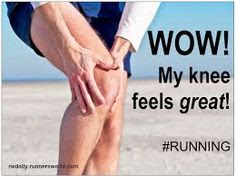There’s no denying the difference that Crossfit training has made in my running. I credit all of that to the change in my training, which is lower mileage and more strength training/interval training. In fact, Becky herself is working on a testimonial about the change CrossFit has made for her. This is her 5 year anniversary doing CrossFit, and you can see from the pictures what a change she has made in her physique, as well as the way she carries herself. Becky is a big believer in CrossFit, but interestingly, when I asked her about CrossFit Endurance, she told me NOT to read the book. So she’s not drinking the koolade. It’s why I love her. The heavy weight lifting I do with her is not specific to CrossFit.
 |
| Becky’s transformation |
A recent study found that for masters athletes, heavy lifting increased running efficiency. Increasing muscle strength by lifting weight will give you more power and faster muscle contractions.
“When muscles don’t need to work as hard, they also don’t require as much oxygen or circulating blood and therefore will not put as much demand on the heart, which in turn will lower that rate at which it beats. A significant improvement in endurance will be the result. Greater strength does equal greater endurance.” –Brendan Brazier, How to Build Strength to Improve Muscle Efficiency
Strength training also improves coordination because lifting heavy weights forces us to be really conscious of our positioning. Being a natural klutz, I was pleased to see that. Practicing the skill of weightlifting over time leads to better form on the road and less repetitive stress injuries as well.
 |
| Don’t think I’ll be winning any bodybuilding competitions! |
Running is, by nature, a weight bearing activity. Swimmers and cyclists are at more risk for bone density loss than runners. Older athletes lose muscle mass at a much higher rate than younger athletes, and women in particular are at risk for bone density loss. But no matter what sport you participate in, or what age you are, you need muscle mass to support your joints, which is why strength training is so important. And strength training also improves muscle imbalances, which can also lead to injury.
 |
| Perpetuating the myth of bad knees… |
One thing I hear all the time, when people find out I’m a runner, is “you’re going to ruin your knees.” The myth that running is bad for the knees is that–simply a myth. A large study, published last year, found that runners have half the incidence of knee osteoarthritis compared to walkers. This is becauserunning has been shown to thicken the cartilage in your knees. Knee pain is more likely to be caused by muscular imbalance than anything structural. Here is where strength training comes in! A recent review has shown that weak hips can lead to knee pain, particularly patellofemoral pain syndrome or so-called “runners’ knee”. Hips don’t lie. Neither do the glutes. Most of us are quad dominant, meaning we rely more on our quadriceps muscles to propel us forward vs the hamstrings and the glutes. In order to prevent injury, we need to balance things out.
Oh, and by the way, you don’t need to do a lot of strength training. Once or twice a week is sufficient. When Becky and I are doing a heavy lifting cycle, we work together once a week, for 30 minutes. That is all that is needed to make a difference. Believe it or not.
As a runner, what exercises should we be doing to prevent injuries?
